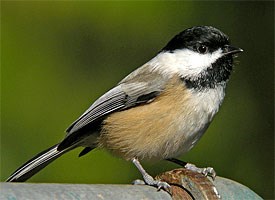
A bird almost universally considered “cute” thanks to its oversized round head, tiny body, and curiosity about everything, including humans. The chickadee’s black cap and bib; white cheeks; gray back, wings, and tail; and whitish underside with buffy sides are distinctive. Its habit of investigating people and everything else in its home territory, and quickness to discover bird feeders, make it one of the first birds most people learn.
Size & Shape
This tiny bird has a short neck and large head, giving it a distinctive, rather spherical body shape. It also has a long, narrow tail and a short bill a bit thicker than a warbler’s but thinner than a finch’s.
Color Pattern
The cap and bib are black, the cheeks white, the back soft gray, the wing feathers gray edged with white, and the underparts soft buffy on the sides grading to white beneath. The cap extends down just beyond the black eyes, making the small eyes tricky to see.
Behavior
Black-capped Chickadees seldom remain at feeders except to grab a seed to eat elsewhere. They are acrobatic and associate in flocks—the sudden activity when a flock arrives is distinctive. They often fly across roads and open areas one at a time with a bouncy flight.
Habitat
Chickadees may be found in any habitat that has trees or woody shrubs, from forests and woodlots to residential neighborhoods and parks, and sometimes weedy fields and cattail marshes. They frequently nest in birch or alder trees.
Calls
Chickadees make their chickadee-dee-dee call using increasing numbers of dee notes when they are alarmed. They also have a gargling call, often given aggressively when a lower-ranking bird gets close to a higher-ranking one; also exchanged between members of a pair. Black-capped Chickadees make a high pitched see as a high-intensity alarm call, often when a fast-approaching predator is detected. When chickadees hear this call, they freeze in position until they hear a chickadee-dee call signifying “all clear.” High see calls most often given by males.
Cool Facts
The Black-Capped Chickadee hides seeds and other food items to eat later. Each item is placed in a different spot and the chickadee can remember thousands of hiding places.
Every autumn Black-capped Chickadees allow brain neurons containing old information to die, replacing them with new neurons so they can adapt to changes in their social flocks and environment even with their tiny brains.
Chickadee calls are complex and language-like, communicating information on identity and recognition of other flocks as well as predator alarms and contact calls. The more dee notes in a chickadee-dee-dee call, the higher the threat level.
Winter flocks with chickadees serving as the nucleus contain mated chickadee pairs and nonbreeders, but generally not the offspring of the adult pairs within that flock. Other species that associate with chickadee flocks include nuthatches, woodpeckers, kinglets, creepers, warblers and vireos.
Most birds that associate with chickadee flocks respond to chickadee alarm calls, even when their own species doesn’t have a similar alarm call.
There is a dominance hierarchy within flocks. Some birds are “winter floaters” that don’t belong to a single flock—these individuals may have a different rank within each flock they spend time in.
Even when temperatures are far below zero, chickadees virtually always sleep in their own individual cavities. In rotten wood, they can excavate nesting and roosting holes entirely on their own.
Because small songbirds migrating through an unfamiliar area often associate with chickadee flocks, watching and listening for chickadee flocks during spring and fall can often alert birders to the presence of interesting migrants.
The oldest known wild chickadee lived to be 12 years and 5 months old.